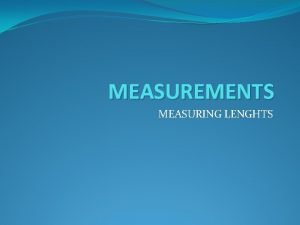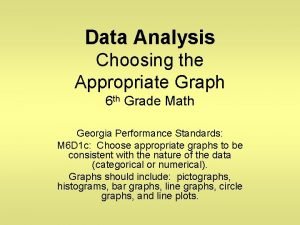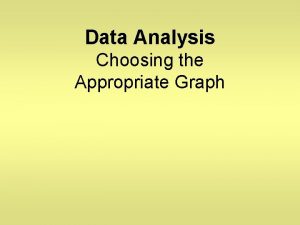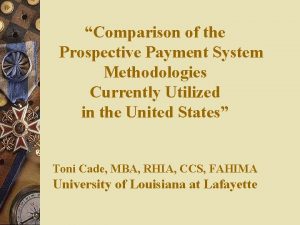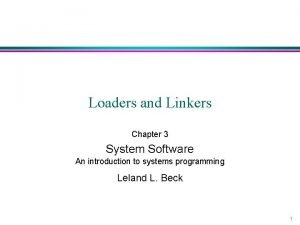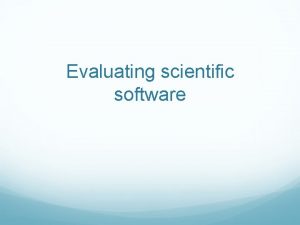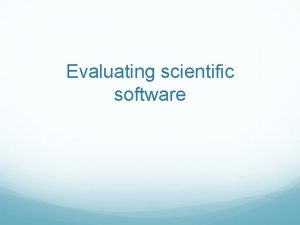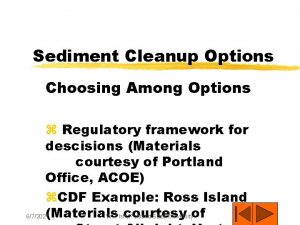Evaluating scientific software Choosing appropriate software Options 1











- Slides: 11

Evaluating scientific software

Choosing appropriate software. Options. 1. Create your own from scratch. 2. Create your own with key bits from well-developed, professionally written libraries (e. g. LINPACK). 3. Use or modify somebody else’s – in-house. 4. Use professionally developed packages. Great for what it is designed for, hard to modify. 5. Use UNIX tools (e. g. shell scripting) to create a pipeline that executes existing pieces, including some of the above. 6. Each option has its pros and cons. 7. Different stages of the project may require different approaches. E. g. make no sense to spend a lot of time on #1 just to test out various algorithms.

speed Two key properties of scientific software/algorithm accuracy

speed Two key properties of scientific software/algorithm Genius typical accuracy

Assessing accuracy Generally hard. Best – against experimental observations. Example: protein folding prediction against experimentally determined protein structures. RMS deviation from experiment. Often hard: multivariable. Not every method predicts experimental outcome directly. By proxy, against “industry standard” methods of known quality. The reference methods are often slower, but more accurate. Example: coarse-grained methods against full calculations. Monte Carlo against exhaustive search.

Example: protein prediction by homology modeling to known proteins accuracy Similarity to a known protein

Comparing speeds Obviously, the new and the reference method must compute the same quantity. Ideally, compare at fixed accuracy. Hard. Sophisticated methods have complex accuracy/speed trade-offs, controlled by multiple parameters. Example: solve PDE via finite difference. Lattice spacing and order of the method control both accuracy and speed. Have to be an expert, ideally the developer. Relatively easy: compare two methods by setting parameters to their recommended defaults. A set of benchmarks that everyone recognizes. For example: LINPACK benchmarks for testing supercomputers.

Testing supercomputers: Solve Ax = b using a version of Gaussian elimination A = random, non-sparse Nx. N matrix, entries between [-1, 1]. So is b. Expected compute time = O(N^3). Obviously, need to test various n, usually spanning at least an order of magnitude. Test speed as a function of # of CPUs used AND the size of the problem n. Maintain fixed accuracy

Testing supercomputers Speed (appropriate units) r ea s ng li ca lin l a Ide em l b ro rp rge a l c, i ist l a re ic ist l a e r # of compute units 1 2 4 8 16 32 64 128

Example of professional (speed) benchmarking AMBER 12 NVIDIA GPU ACCELERATION http: //ambermd. org/gpus/benchmarks. htm SUPPORT

Benchmarking scientific software that are not based on exactly the same algorithm Not meaningful to compare speeds within a factor of 2, only ballpark comparisons make sense. Usually can get a factor of two by tweaks to compiler options, etc. Example: B. Aguilar and A. V. Onufriev, Efficient Computation of the Total Solvation Energy of Small Molecules via the R 6 Generalized Born Model J. Chem. Theory and Comp
 Choosing appropriate metric units of measurement
Choosing appropriate metric units of measurement Appropriate graph
Appropriate graph Essential questions for data analysis
Essential questions for data analysis Scientific inquiry vs scientific method
Scientific inquiry vs scientific method How is a scientific law different from a scientific theory?
How is a scientific law different from a scientific theory? A computer software program that assign appropriate ms-drgs
A computer software program that assign appropriate ms-drgs Linkage editors
Linkage editors Loader options in system software
Loader options in system software Choosing foods wisely quiz
Choosing foods wisely quiz Choosing abstinence quiz
Choosing abstinence quiz Choosing healthful foods lesson 25
Choosing healthful foods lesson 25 Disadvantages of labour saving devices in the kitchen
Disadvantages of labour saving devices in the kitchen
